16 September 2022
Clamour for glamour: Why Art Deco continues to dazzle
5 minutes
The discovery of King Tutankhamun’s tomb by British archaeologist Howard Carter and the 5th Earl of Carnarvon in November 1922 sparked a wave of Egyptomania, inspiring jewellery, furnishings, architecture, film and fashion. Here Emily Barber, Bonhams Head of Jewellery, UK, discusses the allure of Art Deco jewellery with Aston Lark Private Clients Director Julie Webb
“Jewellery is increasingly being reassessed as an art form, not just the sum of its precious components, and Art Deco jewellery from the 1920s to 1930s is particularly valued for superior design, skilled craftsmanship, wearability and individual beauty.
The excavation of Tutankhamun’s tomb by Howard Carter and the 5th Earl of Carnarvon, after entering the burial chamber on November 26, 1922, inspired designs that encapsulated the aesthetic of ancient Egypt while looking refreshingly modern at the same time.
Egyptian revival jewels from the Art Deco period continue to inspire us today with their technical brilliance and chic, timeless designs. It was an exciting time of daring creativity and ground-breaking technical innovation.
What buyers should look for
When buying Art Deco jewellery, buyers should look for rare designs by the major jewellery houses and smaller workshops who produced jewels for them during the Art Deco period. It is best to consult specialists on signatures and maker’s marks, overall condition and quality of manufacture. Distinctive features such as Eastern influences, ancestral gems and provenance are also interesting elements to look out for.
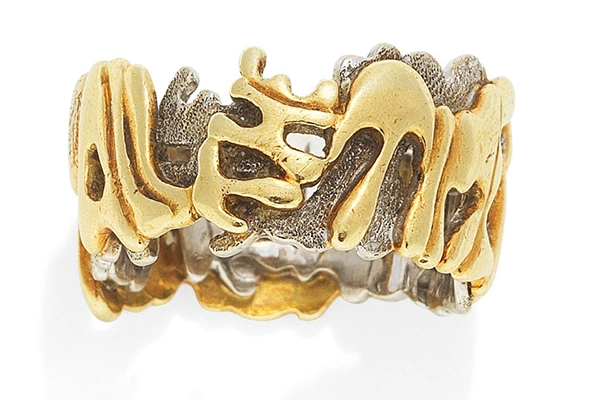 |
(Image: All the time in the world ring unsigned size I estimate £8,000 – £12,000. Charles de Temple. Circa 1965 – Credit: Bonhams.)
What’s popular and why
The geometric and Eastern-inspired forms that emerged during the early Art Deco era became more sculptural and three-dimensional as the movement progressed into the 1930s. After World War One, a range of historical design influences were reimagined for a new optimistic generation and there were huge leaps in technical artistry, so buyers have an enormous variety of styles and categories to explore.
Imaginative colour combinations, carved gems and the use of new geometric diamond cuts epitomise the glamour and fast pace of the jazz age, which remains compelling for buyers today. Signed and rare jewels by the leading maisons of the day, such as Bulgari, Boucheron, Cartier, Chaumet, Drayson, Mauboussin, Tiffany and Van Cleef & Arpels are also highly desirable and fiercely contested at auction.
Glimpse into a glamorous past
Period jewels are highly personal and offer a glimpse into the life and times of the people who owned and wore them. It is this combination that makes collecting period jewels so irresistible.
The international success of films and period dramas, such as Baz Luhrmann’s ‘The Great Gatsby’ (2013) and ‘Downton Abbey’, has also increased interest in the Art Deco era, as well as attracting new markets in Asia and the Far East, where period jewels have soared in value.
The use of genuine Art Deco jewels in film and television provides a wonderful insight into how Art Deco jewels, such as aigrettes, clip brooches and sautoirs were worn during the era. By bringing these jewels to life on screen, potential buyers can also see how they might be incorporated into a contemporary wardrobe and lifestyle.
Coming up at auction
Bonhams London Jewels sale on September 21 features Art Deco jewellery pieces created by renowned names including Fouquet and Cartier from a single-owner collection.
I am particularly excited about an exquisite pair of Mauboussin natural pearl and diamond pendant earrings. Circa 1930, the elegant, deceptively simple geometric lines combine with numerous different cuts of diamond and a pair of exquisite natural pearls. The estimated price is £70,000 to £100,000.
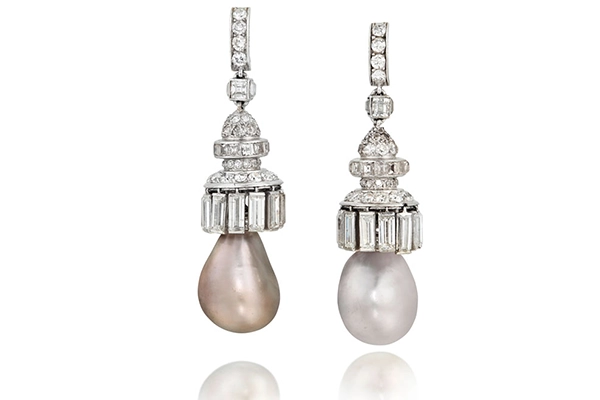 |
(Image: A pair of natural pearl and diamond pendent earrings, estimate £50,000 – £80,000. Mauboussin. Circa 1930 – Credit: Bonhams.)
I also love the gorgeous Henri Picq ‘Tutti Frutti’ double-clip brooch, circa 1930. Each openwork clip is composed of twisting vines from a central ogee motif. It is set throughout with brilliant, old brilliant, single and baguette cut diamonds with leaf-shaped carved rubies and sapphires and fluted emerald beads studded with diamonds. It has the maker’s mark Henri Picq (1861-1941) and is estimated at £50,000 – £70,000.
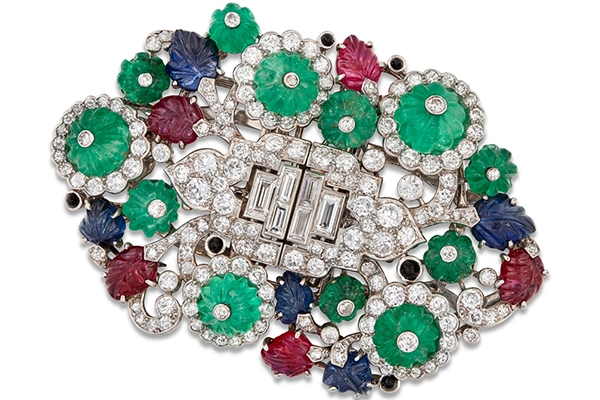 |
(Image: A multi gem set and diamond Tutti Frutti double clip brooch, estimate £50,000 – £70,000. Henri Picq. Circa 1930 – Credit: Bonhams.)
We also have an exceptional gem-set bead and diamond necklace, circa 1925, by Cartier which is set with rows of graduating turquoise beads alternating with tiny ruby spacers, emulating the knots in red silk. It is connected each side with old brilliant and single-cut diamond geometric plaques depicting stylised lily-of-the-valley. It is signed Cartier with a provenance of formerly being part of Alice Lurcy’s jewellery collection, the wife of French investment banker George Lurcy. The necklace is offered with an estimate of £50,000 to £80,000.
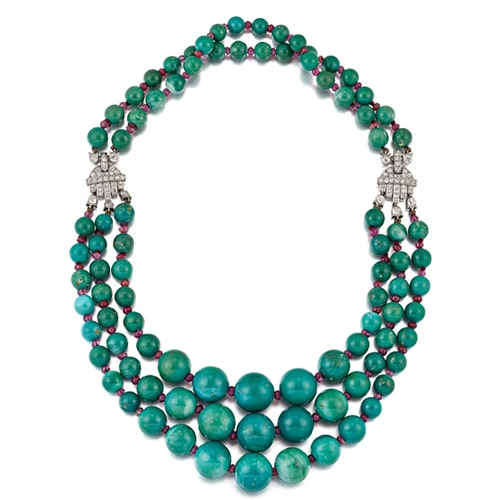 |
(Image: A gem-set bead and diamond necklace, estimate £50,000 – £80,000. Cartier. Circa 1925 – Credit: Bonhams.)
A large circular fancy-cut citrine and diamond pendant signed by Georges Fouquet (1862-1957), circa 1920, is a fabulous example of the evolution of Fouquet’s exquisite work, showcasing how he moved away from Art Nouveau towards the modern styles of the early 20th century with bolder, more streamlined aesthetics. The pendant is mounted within three dart-shaped claws decorated with rose-cut diamonds, suspended from a rose-cut diamond circular pendant, mounted in platinum. Estimate of £30,000 to £50,000.
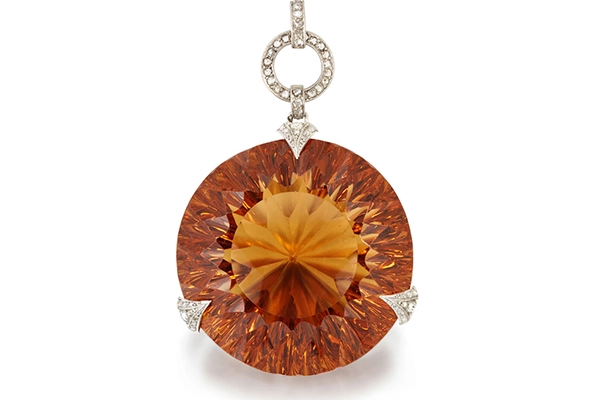 |
(Image: Citrine and diamond pendant estimate £30,000 – £50,000. George Fouquet. Circa 1920 – Credit: Bonhams.)
The auction also includes a 1930s Van Cleef & Arpels diamond and gem-set flower spray brooch resembling the one worn by Margaret, Duchess of Argyll (1912-1933) in her 1931 portrait by Gerald Leslie Brockhurst (now in the collection at Tate London). It depicts the gold floral embroidery of the Duchess’s black gown, alongside a similar diamond and gem-set brooch pinned upside down at the centre of her dress.
The yellow gold engraved brooch with a fluttering ribbon and diamond flowers within larger yellow gold crafted petals is scattered with rubies, sapphires, emeralds and diamonds. It is estimated at £20,000 – £25,000.
Remember to arrange regular valuations
Whether you are a long-term collector or new to buying jewellery, remember the importance of regular valuations.
Insurers recommend that you obtain a jewellery valuation at least every five years, preferably three in today’s market. But check your schedule and policy wording for specific requirements.
Insurers will require any valuation to be for “insurance purposes” and for retail value. You should also consider how you would replace your jewellery in the event of a loss. Would you want a brand new replacement with a modern equivalent (New Replacement Value) or would you prefer an antique replacement (Antique Replacement Value)?
Ensure the items are photographed, kept in good condition and your documentation is in a safe place to help in the event of a claim. It’s a good idea to send a copy of your valuations to your broker, whether or not the insurer requires it.
Howden are specialists in finding the right jewellery insurance solution, something you should never have to do on your own. We understand the value of a good policy and will help you protect your passion and investment.
To speak to Howden about insuring your jewellery call 020 8256 4901, email private.clients@howdeninsurance.co.uk.
Next auctions
Bonhams London Jewels auction is on 21 September 2022 followed by its Knightsbridge Jewels auction on 12 October 2022. Visit bonhams.com
